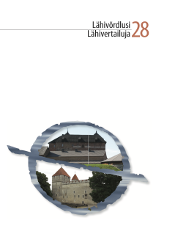NUT-partisiipin variaatiosta rajakarjalaismurteissa: (n)nA-, n- ja nUn-partisiippien keskinäisestä suhteesta
Three variants of the active past participle in Border Karelian dialects
Author(s): Ilia MoshnikovSubject(s): Language studies, Recent History (1900 till today), Syntax
Published by: Eesti Rakenduslingvistika Ühing (ERÜ)
Keywords: active past participle; variation; language contact; statistical analysis; Finnish; Karelian;
Summary/Abstract: This article investigates the relationship between three variants of the active past participle in Border Karelian dialects, using statistical methods. Border Karelia is the name used for the easternmost corner of pre-war Finland, where the Karelian language was spoken. After World War II, as this region was annexed to the Soviet Union, its inhabitants were resettled in other parts of Finland; most Karelian speakers living in Finland nowadays are Border Karelian evacuees or their descendants. So far, Border Karelian dialects have not been extensively researched, but there is a Corpus of Border Karelia (RajaKarjalan korpus) based on dialect interviews conducted in the 1960s and 70s. Te data for this study comes from this corpus. Participle variation is one of the examples of morphological variation and language contact. Te so-called essive participle in -nna (sano-nna ‘said’), historically an essive case form of the Finnic NUT participle, is characteristic of the Finnish East Savo dialects, but it also appears in Border Karelian. According to Larjavaara’s hypothesis (1995) the essive participle evolved from the older Karelian variants n or nUn (sano-n ~ sano-n-na ‘said’, näh-nyn ~ näh-nyn-nä ‘seen’). These two other frequent participle variants in -n and -nUn are typical of the Karelian Proper varieties of the Karelian language. Te data used in this study consists of 482 tokens of participles; of these, 190 are essive participles, 159 are of the n type, and 133 of the nUn type. In this study, the correlations between morpheme variants and morph syntactic factors as well as the territorial distribution of these variants in Border Karelian dialects were analyzed. The study reveals that different variants of the past participle favor different morph syntactic contexts. The essive participle is typical of Ilomantsi in the westernmost Border Karelian area, and it occurs especially in negative past-tense forms of verbs with the stem vowel U or with a stem-fnal long vowel or diphthong. Te n-type participle appears statistically significantly with verbs with the stem vowel A in negative contexts in the Impilahti and Suojärvi areas. The nUn-variant favours verbs with the stem vowel e and is most frequent in Suojärvi. Te occurrence of different participle variants in different contexts indicates that the essive participle was first adopted from Finnish to Karelian in a specific context. These results support Larjavaara’s hypothesis and demonstrate the effect of the language contact across time. The essive participle probably superseded the older variant in the Ilomantsi area, while in the rest of Border Karelia older variants remained in use much longer.
Journal: Lähivőrdlusi. Lähivertailuja
- Issue Year: 2018
- Issue No: 28
- Page Range: 263-284
- Page Count: 22
- Language: Finnish

